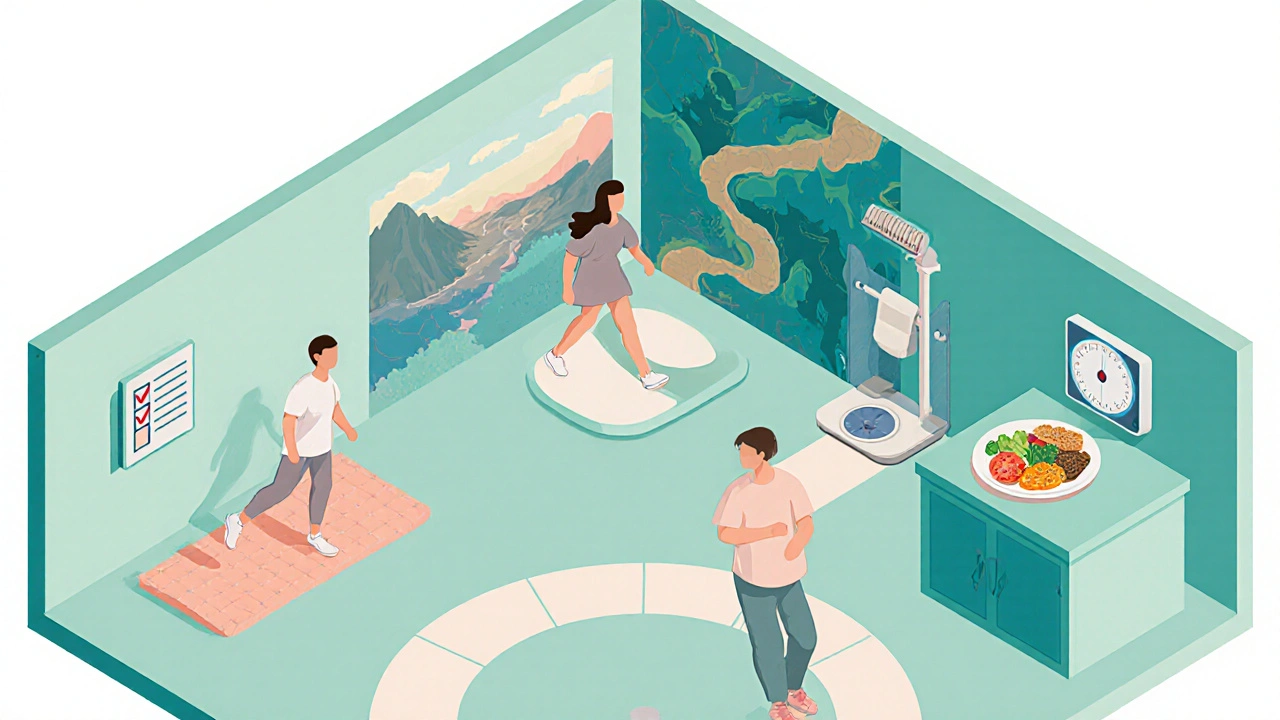Loxapine Side Effect Tracker
Daily Side Effect Log
Recent Tracking
Pattern analysis helps identify dosage adjustments or treatment changes.
Severe muscle rigidity, high fever, or confusion require immediate medical attention.
When prescribed Loxapine is a typical antipsychotic medication used mainly for schizophrenia and bipolar disorder, patients often wonder how the drug’s side‑effects will affect daily life and what they can do to stay comfortable.
Quick Takeaways
- Start with a low dose and increase slowly to let your body adjust.
- Track side effects daily; patterns give clues about dosage or timing tweaks.
- Hydration, balanced meals, and regular movement counteract many physical symptoms.
- Talk to your prescriber about adding short‑term anticholinergic meds for tremors.
- Never stop loxapine abruptly-taper under medical supervision.
Understanding Why Side Effects Occur
Loxapine works by blocking dopamine D2 receptors and, to a lesser extent, serotonin receptors. This helps calm psychotic thoughts but also interferes with normal neurotransmission in other brain areas, leading to a range of side effects.
Common categories include:
- Motor symptoms - such as Extrapyramidal Symptoms (EPS), which cover stiffness, tremor, and restlessness.
- Central nervous system effects - sedation, dizziness, or cognitive dulling.
- Metabolic changes - weight gain and altered blood sugar.
- Cardiovascular impacts - orthostatic hypotension and occasional tachycardia.
Knowing the root cause helps you choose the right counter‑measure.
Step‑by‑Step Routine for Side‑Effect Management
- Set a Baseline
- Write down your current weight, blood pressure, and any existing movement issues.
- Use a simple side‑effect diary (date, symptom, severity 1‑5).
- Start Low, Go Slow
Most clinicians begin at 5‑10mg/day. If tolerated, increase by 5mg increments every 1‑2 weeks. This gradual climb reduces the shock to dopamine pathways.
- Timing Matters
Take loxapine in the evening if sedation is strong. If daytime drowsiness interferes with work, split the dose (e.g., 5mg morning, 5mg evening).
- Combat Motor Symptoms
- For mild EPS, consider over‑the‑counter magnesium or a scheduled stretch routine.
- When tremor or rigidity becomes noticeable, ask your prescriber about adding an anticholinergic like benztropine for a short period.
- If symptoms persist, a dose reduction or switch to a newer atypical antipsychotic may be warranted.
- Manage Sedation and Cognitive Fog
- Limit caffeine after noon; caffeine can mask sedation and make you underestimate drowsiness.
- Engage in short, brisk walks (10‑15minutes) twice a day to boost alertness.
- Stay hydrated - dehydration can amplify dizziness.
- Watch Metabolic Health
Weight gain often stems from increased appetite. Keep a food log, focus on protein‑rich meals, and add a daily 30‑minute activity (walking, cycling, yoga).
- Blood Pressure Checks
Orthostatic hypotension can cause faintness when standing up. Measure your blood pressure sitting and then again after standing for 2minutes. A drop greater than 20mmHg systolic suggests a need for dose adjustment.
- Regular Lab Monitoring
Every 3‑6months, have your clinician order a complete metabolic panel, fasting glucose, lipid profile, and prolactin level. Early detection of glucose spikes or cholesterol changes allows lifestyle tweaks before medication changes.
- Never Abruptly Stop
Stopping loxapine suddenly can cause rebound psychosis or withdrawal dyskinesia. Taper by 5mg every week under medical supervision.

Practical Lifestyle Tweaks to Boost Quality of Life
Medication management is only part of the puzzle. Small daily habits can dramatically lower the burden of side effects.
- Nutrition: Prioritize whole grains, lean proteins, and plenty of vegetables. Omega‑3 rich foods (salmon, walnuts) may also ease mood swings.
- Sleep Hygiene: Keep a consistent bedtime, limit screens an hour before sleep, and consider a light‑blocking curtain if you experience vivid dreams.
- Stress Reduction: Mindfulness apps, gentle yoga, or a short journaling session each evening can lower cortisol, which in turn reduces appetite spikes linked to weight gain.
- Support Network: Share your side‑effect diary with a trusted family member or therapist. External accountability often leads to quicker adjustments.
- Physical Therapy: If EPS become troublesome, a PT can teach targeted stretches that improve range of motion and reduce muscle stiffness.
When to Call Your Healthcare Provider
Not all side effects are equal. Here’s a quick rule‑of‑thumb checklist:
| Symptom | Urgency | Suggested Action |
|---|---|---|
| Severe muscle rigidity, high fever, confusion | Urgent (possible Neuroleptic Malignant Syndrome) | Go to ER or call emergency services immediately |
| Persistent tremor or restlessness affecting daily tasks | High | Contact prescriber for possible anticholinergic addition or dose tweak |
| Unexplained weight gain >5% in a month | Medium | Schedule a nutrition consult and discuss dosage |
| Dizziness when standing | Medium | Check blood pressure; consider slower dose titration |
| Sleepiness that interferes with work | Low | Adjust dosing time or split dose |

Frequently Asked Questions
Can I take loxapine with other antipsychotics?
Combining two antipsychotics can increase the risk of severe EPS and cardiac side effects. Doctors only do it in rare, closely‑monitored cases. Always discuss any medication changes with your prescriber.
Is weight gain inevitable on loxapine?
Not everyone gains weight, but the risk is higher than with some atypical agents. Eating balanced meals, staying active, and checking weight every two weeks help catch changes early.
What is the best time of day to take loxapine?
If you feel drowsy, take it in the evening. If it makes you jittery, a split dose (morning+evening) can balance the effect. Your prescriber can fine‑tune the schedule.
How long before side effects subside after a dose change?
Most side effects improve within 1‑2weeks of a dosage adjustment, but motor symptoms may take up to a month to settle.
Should I stop loxapine if I feel better?
No. Stopping abruptly can cause a relapse of psychotic symptoms. Follow a taper plan approved by your clinician.
Next Steps If Problems Persist
Even with diligent self‑care, some patients still experience intolerable side effects. Here’s what to do next:
- Request a medication review - Your prescriber can order plasma level testing to see if blood concentrations are higher than expected.
- Consider a switch - Options include aripiprazole, ziprasidone, or newer injectable formulations that may have a cleaner side‑effect profile.
- Seek a second opinion - A psychiatrist specializing in treatment‑resistant cases can offer alternative strategies, such as adjunctive mood stabilizers.
Remember, managing Loxapine side effects is a partnership between you, your healthcare team, and the routines you build into your day. With the right plan, you can keep the medication’s benefits while minimizing its drawbacks, leading to a steadier, more comfortable life.
